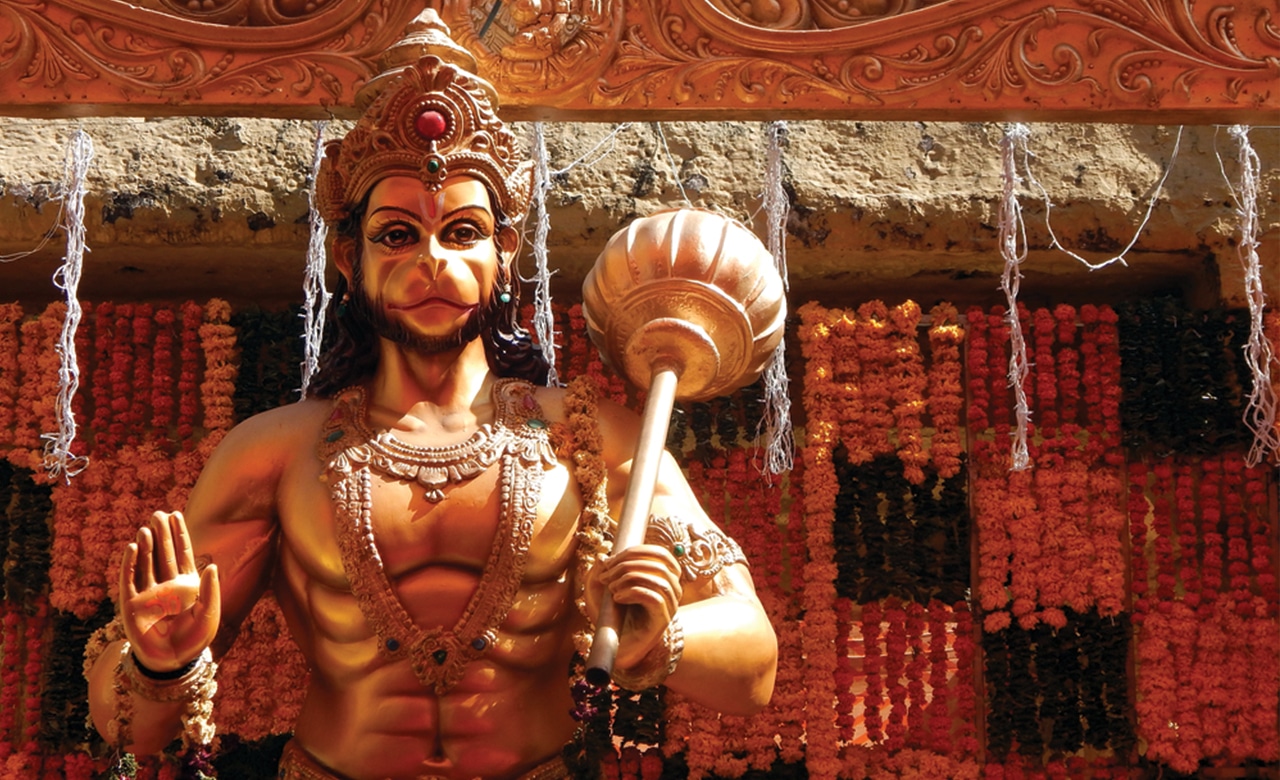
Informative
Unknown Facts About Lord Hanuman
Ramayana is the second-largest epic known to humanity. One cannot imagine Ramayana, Lord Ram’s story, without Lord Hanuman. He is considered the greatest devotee of Prabhu Ram and is greatly adored and praised by devotees of all ages, genders and castes in India.
Hanuman was born to Maa Anjana and King Kesari by the blessings of VayuDev, the Lord of Winds. He possesses many characteristics that make Him unique: He has great physical strength; He can fly over long distances; He can change his size at will; He has an extraordinary memory; He can understand what people say without hearing them speak out loud; He speaks several languages fluently including Sanskrit.
Lord Hanuman, who is known for his extraordinary presence, has lived a life that’s even more astounding and filled with fascinating details. So we found some lesser-known exciting facts about this larger-than-life Divinity and thought you’d like to know!
The incarnation of Shri Mahadev -Lord Shiva .
Ravana had created havoc on earth with his demonic forces, and hence, Lord Vishnu decided to take birth as a human in the form of Rama to cleanse the earth of demonic sins. To aid Lord Vishnu, all the Gods in heaven sent their energies to take birth on earth in mortal bodies.
Lord Brahma had a son named Jambuvant. Vali was born due to the blessings of Indra, and Sugriv was born due to the boon of Surya Dev. Great Vanara King Gandhamaadana was born from the blessings of Lord Kubera. At the same time, Viswakarma created Nala, who was responsible for building the legendary bridge to Lanka. Neela was born from the blessings of Agni Deva.
Ferocious Vanara warriors Mainda and Dvivida were born due to the blessings of Ashvini Kumars. The Rain God Varuna created the great fighter Sushena, and the Thunder God gave rise to Sarabha. Same as that, born from Lord Vayu’s blessings, Hanuman was Lord Shiva’s incarnation.
He had another name before the world started calling him Hanuman.
Hanuman is derived from the Sanskrit word Hanumat, which means one whose jaw has swollen or disfigured. Hanuman was named Maruti by his Mother Anjana. When Maruti was a child, the Sun looked like a ripe fruit to Him in his hunger, and He tried to grab it by jumping into space. But Indra became angry when He saw this audacity! Indra struck down little Maruti with a lightning bolt, leaving the child’s jaw (Hanu) scarred for life.
The celibate had a son.
This beloved God is considered a lifelong celibate, yet he fathered a son named Makardhwaja. The story goes that after burning Lanka with his fiery tail, Maruti went back to India by crossing the sea. While flying above the sea, one drop of his sweat fell off into the sea and was ingested by a fish. That fish gave birth to a son, who was known as Makardhwaja.
He fought in Ramayana. But what about Mahabharata?
After the devastating war of Ramayana, the world saw the second most ferocious battle on this earth in the form of Mahabharata. Do you know that Lord Hanuman was also present in this second war?
Lord Krishna is considered the reincarnation of Lord Vishnu. Lord Krishna asked Lord Hanuman to be present on the battlefield, on the top of Arjuna’s chariot. While sitting on the top of the chariot, Lord Hanuman protected Arjuna’s chariot from all kinds of weapons. When Arjuna won the battle, re-establishing the Dharma, Lord Krishna asked Hanuman to get down from the chariot. As soon as he alighted from the chariot, that empty chariot was reduced to ashes due to the devastating effect of various celestial weapons it endured during the war.
He was the first one to listen to Bhagvat Geeta.
The Bhagavad Gita, or the “Song of God,” is a discourse in which Lord Krishna explains life to Arjuna before the start of a great battle of Mahabharata. It is considered one of the most profound spiritual discourses known to humankind. While the Bhagavad Gita is many centuries old, its timeless wisdom can help us understand how everyday life works.
Even though it’s widely believed that Sanjay, the charioteer of Dhritarashtra with clairvoyance, heard Bhagvat Geeta firstly, it was Lord Hanuman who heard it first when He was sitting on the chariot of Arjuna.
He wrote Ramayana.
It’s common knowledge that Sage Maharshi Valmiki wrote Ramayana. Lord Hanuman was well versed in Vedas and Sanskrit Grammar. It is believed that Lord Hanuman wrote down his version of Ramayana, and His version was so brilliant, glorious, and splendid that it gave the complex to Valmiki. Blessed with the gift of a great memory, Lord Hanuman discarded His version of Ramayana, realizing he could relive these moments any time, giving Sage Valmiki credit for this epic poem.
Immortal One.
Ashwatthama, Balik, Vyas, Vibhishan, Kripacharya, Parshuram, and Markandeya are the Chiranjeevis, or immortals on earth. Lord Hanuman is one of them. After reading Valmiki’s Ramayan, all the Gods were pleased with him. They praised the epic, saying as long as there are Sun and moon present in the skies, and as long as there are mountains on earth, Valmiki’s Ramayana shall be remembered and shall be sung by the devotees.
On the other hand, Prabhu Ram gifted Hanuman to stay alive as long as there is someone who is reading, singing, acting, or meditating on the Ramayana on this earth. As a result of these two boons, Lord Hanuman became immortal. It is believed that whenever there is a reading, chanting, or acting of Ramayana is done, Lord Hanuman comes and sits there, listening to the glories of his master. In many places where Ram Katha, or the story of the Rama, is told, one seat is kept vacant for Lord Hanuman.
A talented singer.
Once, a competition took place between Garuda and celestial singer Tumbaru about who was the greatest singer among them. Laughing at this silly competition, Sage Narada told them that neither of them is the greatest as long as Hanuman walks on earth. Garuda and Tumbaru decided to test this theory.
They came down to earth, and Tumbaru gave his Veena (stringed musical instrument) to Hanuman and asked him to sing. As Hanuman started singing, the stone where he placed the Venna melted. The rock became solid again when he completed the song, resulting in sticking down that musical instrument. Then, both Garuda and Tumbaru took turns singing, but they were unable to remove Veena from the stone. Realizing their mistake, both of them asked Hanuman to sing yet again to release the Veena. Hanuman sang, and the Veena was released, thanks to his great vocal skills, melting down the stone below.
Creator of Surya Namaskar.
The Sun Salutation is the most common yoga practice. It is a series of twelve movements that link poses together to form one fluid movement, mastering your breath, mind, and muscles. After learning everything from Lord Surya, Hanuman requested Lord Surya to ask for a Guru, Dakshina. Still, Lord Surya politely declined it, as it was a blessing to have a student like Hanuman. So, meditating on the movements of the Sun in the universe, Hanuman created one exercise regime, offering salutations to the Sun, which we know today as Surya Namaskar.
We hope you enjoyed reading about a few lesser-known stories revolving around Lord Hanuman.
Please subscribe to our mailing list to stay connected and receive spiritual information. In case of any queries, please write to us at info@chamundaswamiji.com. You can check out our YouTube channel Chamunda Swamiji where you can learn Tantra, Mantra, Yantra, and Meditation from His Holiness Shri Chamunda Swamiji. If you seek to learn Shakti Kriya, please register with us, and we will get back to you.
Post a Comment
-
Subscribe to Our Blog
-
Categories
-
Popular Articles
- Dead moth in the house. What universe is trying to tell you?
- Vivah Bandhan Curse – What Is It and How to Spiritually Heal It.
- Tripura Sundari | The Dasa Mahavidya
- What are Beej Mantras?
- The Dasa Mahavidyas
- Ramakrishna Paramhansa – The Man who almost became a Woman
- Maa Bhuvaneshwari | The Dasa Mahavidyas
- Maa Chinnamasta | The Dasa Mahavidyas
- How does the Moon Affect Us?
- Maa Bhairavi | The Dasa Mahavidyas



